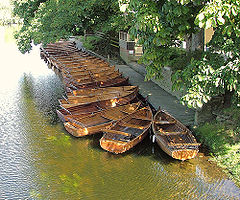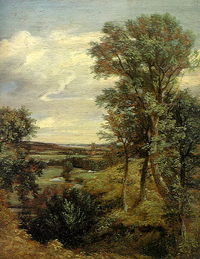- Dedham, Essex
-
Coordinates: 51°57′32″N 0°59′36″E / 51.95888°N 0.99341°E
Dedham 
River Stour, Dedham, Essex.
 Dedham shown within Essex
Dedham shown within EssexOS grid reference TM057331 District Colchester Shire county Essex Region East Country England Sovereign state United Kingdom Post town COLCHESTER Postcode district CO7 6 Dialling code 01206 Police Essex Fire Essex Ambulance East of England EU Parliament East of England UK Parliament North Essex List of places: UK • England • Essex Dedham is a village within the borough of Colchester in northeast Essex, England, situated on the River Stour and on the border of Essex and Suffolk. The nearest town to Dedham is the small market town of Manningtree.
Contents
Geography
Dedham is frequently rated as containing some of England's most beautiful Lowland landscape, most particularly the Water Meadows of the River Stour, which passes along the northern boundary of the village forming the boundary between the counties of Essex and Suffolk. Dedham has a central nuclear settlement around the Church and the junction of Mill Lane and the High Street (forming the B1029). Connected to Dedham are the hamlets of The Heath and Lamb Corner. The village forms a key part of the Dedham Vale.
John Constable
Dedham is at the heart of 'Constable Country' - the area of England where Constable lived and painted. Constable attended the town's Grammar School (now the 'Old Grammar School' and 'Well House'), and he would walk to school each morning alongside the River Stour from his family's home in East Bergholt. Many of Constable's paintings feature Dedham, including Dedham Mill, which his father owned, and Dedham Parish Church, whose massive Caen stone and flint tower is a focal point of the surrounding Dedham Vale.
Other artists
In 1937, Cedric Morris and Arthur Lett-Haines founded the East Anglian School of Painting and Drawing at Dedham. When, however, this burnt down, they moved to Hadleigh, Suffolk.
Of longer influence in Dedham was horse painter, Sir Alfred Munnings who became President of the Royal Academy. His house in Dedham, Castle House, now contains a gallery of his work, and his studio.
Tom Keating, the art restorer and famous art forger, was a Dedham resident until his death in 1984. He is buried in the churchyard of Dedham Parish Church (Website).
Architecture
Dedham contains a number of well-preserved buildings:
- Dedham Parish Church - St. Mary the Virgin, Dedham; (Website) the present building dates from the late 15th century, and was the last medieval 'wool church' to be completed, albeit in a more economical style that was originally intended. The Ascension by John Constable is on permanent display in the church.[1] A viewing platform on top of the tower (open to the public from Easter to Harvest) gives excellent views of the lower part of the Stour valley.
- Sherman's Hall, a Grade I listed, Georgian-fronted townhouse used as a school until 1873 and now belonging to the National Trust.[2]
- The Old Grammar School, founded by Elizabeth I. The present building dates from 1732 and was attended by John Constable. It is now private residences.[2]
- The Sun Inn, a medieval building that retains its coaching arch.[2]
- A Congregational church built in 1739 is now the Dedham Art and Craft Centre.[2]
- Southfields, Grade I listed, is the most splendid of the many medieval buildings in the village. Formerly a factory used when Dedham was a wealthy wool town it is now a series of cottages.
- Castle House, the home of Sir Alfred Munnings and now the Sir Alfred Munnings Art Museum.[3]
- Assembly Rooms, (Website) The external appearance of the building suggests it is a Victorian building in the classical style, but research carried out as part of refurbishment works in 1998-9 has confirmed that the structure is much older, dating from c.1745. Although it was known as the 'Hewitt Memorial Hall' from 1917-1997 (in gratitude to a local benefactor, William Wilkins Hewitt), it has since reverted to its earlier name.
Economy
Formerly a rich wool town and market town, Dedham is now still a flourishing commercial village, housing a post office, butcher, Co-op, grocers, delicattessen, art shop and various other shops.[2] Agriculture is also important with mainly arable land (sugar beet and wheat) but also cattle grazing on the water meadows and some sheep on Grove Hill. There is an industrial estate near the A12, the main road which passes through the West of the village. A Business Centre and Nursing Home have recently opened.
Local amenities
- Boat Hire[4]
- Tennis Club - Dedham has a tennis club with three all-weather courts and a club house[5]
- Cricket Club - Dedham's cricket club is on the playing fields next to the church. It has its own pavilion[6]
- Dedham has an atypically large number of restaurants and hotels for an English village.[7]
Transport
Transport within Dedham can be done entirely by foot or bicycle. Manningtree can easily be accessed by bicycle or by walking along the banks of the River Stour. Manningtree provides regular, fast commuter services to London and Norwich. Colchester can be reached by bus. School buses service all the schools in Colchester and the independent schools in Ipswich.
Notable people
John Rogers, (c.1570-1636), sometimes referred to as "Roaring" Rogers, who was the most famous preacher of his age, was Vicar and Lecturer of Dedham from 1605-1636.
Matthew Newcomen, (c.1610-1669), a co-author of Smectymnuus (1641), who preached before parliament in 1643, was Vicar and Lecturer of Dedham from 1636-1662.
William Burkitt, (1650-170), author of A Poor Man's Help and Young Man's Guide (1694),and Expository Notes on the New Testament (1700-03), which was in print for more than 150 years, was Vicar and Lecturer of Dedham from 1692-1703.
Dedham is the ancestral home of General William Tecumseh Sherman, of American Civil War fame, whose ancestors emigrated to Massachusetts in the 1630s.[8]
Birthplace of William Haggar (1851-1925), whose pioneering work with film at the start of the twentieth century made him one of Britain's foremost directors.
Osborne Reynolds, (1842-1912), engineer and physicist, who developed the understanding of electricity, magnetism, and fluid flow (part of the equation for determining the change between 'streamline' and 'turbulent' flow is still called a 'Reynold's Number'), was the son of a headmaster of Dedham Grammar School.
References
- ^ "Dedham Parish Church". The Parish Church of St Mary's, Dedham. http://www.dedham-parishchurch.org.uk/. Retrieved 2009-01-25.
- ^ a b c d e Jarvis, Joanne (November 2008). "Dedham delight". Essex Life (Archant): pp. 80–81. http://edition.pagesuite-professional.co.uk/Launch.aspx?referral=other&pnum=&refresh=Qs3051eD1rF8&EID=e2b10cf0-fd31-44b7-837b-a7ba94501771&skip=true. Retrieved 2009-01-24. (Registration required)
- ^ "Sir Alfred Munnings Art Museum". The Castle House Trust. http://www.siralfredmunnings.co.uk/. Retrieved 2009-01-25.
- ^ http://dedhamboathouse.co.uk/
- ^ http://dedhamtennis.org.uk/blog/
- ^ http://dedhamcc.co.uk/
- ^ Mann, Clare (2008-07-14). "Dedham: My kind of town". The Daily Telegraph (London). http://www.telegraph.co.uk/travel/destinations/europe/uk/2402360/Dedham-My-kind-of-town.html.
- ^ William Tecumseh Sherman, Memoirs, The Library of America: 1990, p. 9.
External links
Categories:- Villages in Essex
- Colchester
Wikimedia Foundation. 2010.


